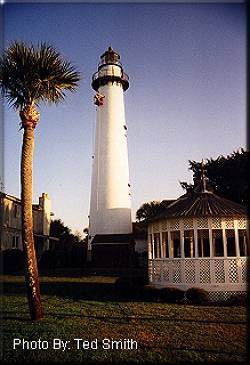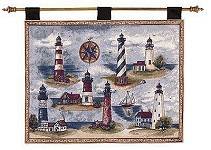 |
Built: 1st lighthouse 1810 / 2nd lighthouse 1872
Type: 1st lighthouse Octagonal Pyramid / 2nd lighthouse Conical Tower
Height: 1st lighthouse 85 feet / 2nd lighthouse 104 feet
Status: 1st lighthouse Non Active / 2nd lighthouse Active
Location: St. Simons Island, Couper's Point
Deactivated: 1st lighthouse Destroyed During the Civil War 1862
Lens: 1st lighthouse Oil Lamps - 1857 Third Order Fresnel / 2nd lighthouse Whale Oil - Kerosene Lamp - 1934 Electricity
Keepers: 1st lighthouse James Gould (1810 - 1837) / 2nd lighthouse Frederick Osborne (1872-1880) - Carl Olaf Svendsen (1907-1935) David O'Hagan (?-1950) (1939) US Coast Guard
Notes: John Couper in October
17, 1804, a plantation owner on St. Simons Island, deeded four acres of
his land, known as "Couper's Point," at the south end of the island for
one dollar to the Federal government for the construction of a lighthouse.
James Gould of Massachusetts was hired in 1807 by the Treasury Department
to build the lighthouse and a one-story frame residence. Original specifications
called for the lighthouse to be built of hard brick; however, for economic
purposes, most of the material used in the construction was "tabby," a
mixture of oyster shell, lime, sand, and water. The uppermost part (12_
feet) was constructed of the "best northward brick." The 75-foot tower,
exclusive of the lantern, was an octagonal pyramid, 25 feet in diameter
at the base, tapering to 10 feet in diameter at the top. The tabby foundation
was eight feet thick at the base. An iron lantern ten feet high and eight
feet in diameter rested on top of the brick and tabby tower, making the
lighthouse 85 feet tall. Oil lamps were suspended on iron chains in the
lantern.
James Gould served as keeper
for twenty-seven years. Twenty years after his departure, the lighthouse
was outfitted with a third-order Fresnel lens in 1857. When the Confederate
troops abandoned the island in 1862, they dynamited the tower and keeper's
cottage, so they would not benefit the Union forces.
Following the Civil War,
noted Georgia architect Charles B. Cluskey drew up plans for a new lighthouse
and dwelling on the island. The impressive Victorian duplex and tower were
complete in 1872 at a cost of $45,000. The light from a third-order, L.
Sautter Company Fresnel lens was first shown on September 1 of that year.
The lens is a fixed lens, meaning it does not contain any flash panels
and thus produces a steady light, however, there are four flash panels
that revolve around the outside of the lens producing a bright flash once
per minute.
Cluskey did not live to
see his lighthouse completed as he died of yellow fever in 1871. Frederick
Osborne, the first head keeper at the new lighthouse, repeatedly complained
about the unhealthy living conditions on the island. The Lighthouse Board
eventually drained the ponds near the lighthouse, greatly reducing the
number of mosquitoes and improving life at the station.
On a Sunday morning in March
of 1880, head keeper Osborne and his assistant had an altercation on the
lighthouse grounds, wherein the assistant shot Osborne dead. The assistant
was later acquitted of murder charges, which may have prevented a peaceful
rest for the departed Osborne, whose service was cut short. During Carl
Svendsen's service as keeper, which lasted from 1907 to 1935, he and his
wife repeatedly heard mysterious footfalls, which would send their dog
Jink into a frenzy. To this day, people claim to hear inexplicable footsteps
in the tower.
In 1890, the brick oil house
was constructed on the grounds to store the volatile kerosene, which replaced
the increasingly expensive whale oil as the lamp fuel. The kerosene was
in turn replaced by electricity in 1934, and the station was automated
sixteen years later in 1950.
The lighthouse keeper's
house served as a home for the lighthouse keepers from 1872 until 1950
when, following the complete automation of the lighthouse in 1953, the
last lighthouse keeper, David O'Hagan, retired, and the passageway was
taken down to separate the lighthouse from the keeper's house. The U.S.
Government then began using the dwelling as office space. It was given
in 1960 to the Bureau of Commercial Fisheries, Department of the Interior,
Fish and Wildlife Service. In 2004, the lighthouse was deeded to the Coastal
Georgia Historical Society under the Lighthouse Preservation Act after
a long a successful lease arrangement with the U.S. Coast Guard and the
Society. Today, with the assistance of the U.S. Coast Guard Auxiliary,
the light continues as an Aid to Navigation, shining seaward every night
and during inclement weather.
| St.
Simons Island - GA
Scaasis Sculpture
|
East
Coast Lighthouse Wall Hangings
|
St.
Simons Island - GA
Lefton Sculpture
|
| You Can Now | Copyright | Credits |
| Contact Us | usalights Store | Shopping Center |



